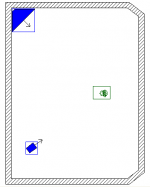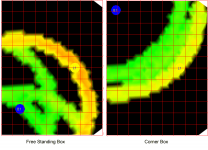I don't understand why the gap is a problem. It's a horn with narrow dispersion, where what comes out is already partially collimated. One could close the gap with wings, but there shouldn't be a need really.This is exactly correct and the reason that I do not think that corner placement is all that great. To be valid the polars would have to be taken with the speaker in a corner just as it is used in practice since this will strongly affect the response. Since no device does not have any radiation outside of its design angle, this radiation bounces off of the walls an interferes with the direct sound. I would expect that the polars would have serious issues in the midband.
I am guessing of course, but without any real data anyone who says otherwise would be guessing as well.
In the picture that you showed before things are even worse. That is because the horn does not actually go all the way to the walls, there is a gap. This gap is likely to be a disaster for a number of reasons.
The way to do this correctly would be to take an Abbey baffle and mount it directly into the corner - no gaps.
This corner placement idea is far from being a proven concept and I suspect that if anyone actually does do the proper measurements they will not look so good.
When the speaker is designed to be free standing and it is placed in the room such that the early reflections are minimized then its direct sound is the free field sound. In the corner placement there is no direct sound which is independent of the walls.
The corner horn will have a uniform response much further down then a free standing horn. It requires however a room with free corners and which is preferable symmetrical.
What I question is the use of a three-way instead of a two-way. Perhaps Wayne can comment on that, but a two-way with a large horn like the Jubilee and low crossover (400-500 Hz) is better IMO. No crossover is perfect. I always find a two-way sounding more coherent then a three-way speaker.
I tried a two-way cornerhorn for a while in the late 1990s. I thought it worked pretty well, but I did feel that it pushed the tweeter too low and the woofer too high. So I chose to go for approximately decade-coverage subsystems, 20-200, 200-2kHz and 2kHz-20kHz. Those aren't the exact crossover points, the mid/tweeter is a little lower, but each subsystem covers approximately a decade.
A two-way like the Jubilee sort of does the midhorn and the tweeter in one, and that's fine but like I said, I preferred to split the band. In my system, tweeter/mid summing is very good, and this approach also lets me run a large midrange driver that can easily blend with the woofer in the upper midbass to lower midrange.
There's a post I made earlier that talks about my design choices, and these things are described in a little more detail.
A two-way like the Jubilee sort of does the midhorn and the tweeter in one, and that's fine but like I said, I preferred to split the band. In my system, tweeter/mid summing is very good, and this approach also lets me run a large midrange driver that can easily blend with the woofer in the upper midbass to lower midrange.
There's a post I made earlier that talks about my design choices, and these things are described in a little more detail.
Wayne - this is simply not true. Any source acts different near a wall even if it is embedded in that wall.
The rest of your comments are all guesses as well - ones that I don't agree with.
Of course it acts different in the wall. It's better, and measurements confirm this. When the source is moved away from the wall, it creates self-interference notches. When it's on the boundary, there are no notches.
Those aren't guesses - those are measurable, verifiable facts. It's really not something you can agree or disagree with, and to say otherwise is a flat earth argument.
I suppose you could argue the audibility of the self-interference notches, but you cannot argue their existance.
I don't understand why the gap is a problem. It's a horn with narrow dispersion, where what comes out is already partially collimated. One could close the gap with wings, but there shouldn't be a need really.
The gap could act like a port to a potential resonator behind the device.
Your comments are all guesses - I guess differently. "Partially collimated"- its got a nice ring to it, but I don't see it making any difference. That's like saying there is no edge diffraction from a horn termination because "it is partially collimated." A horn edge diffracts quite differently if it is terminated in a baffle or open air. Your suggesting that is not true.
THX and a lot of studios use soffit mounting for their main monitors, and benefits are both well proven and measured. Granted it is not exactly the same as full corner soffit, but the gap around the speaker (180° "waveguide"...), cavity resonance, and many other issues are all well known and dealt with in these applications.
Last edited:
Leaving the gap can produce a kind of diffuse echo which seems frequency dependent.I don't understand why the gap is a problem. It's a horn with narrow dispersion, where what comes out is already partially collimated. One could close the gap with wings, but there shouldn't be a need really.
Unless the path taken runs the drivers/baffles beyond their design capabilities, then it will be worse. A non-coincident crossover can't be perfect, but can be made so good that it almost doesn't matter.a two-way with a large horn like the Jubilee and low crossover (400-500 Hz) is better IMO. No crossover is perfect. I always find a two-way sounding more coherent then a three-way speaker.
Those jubilee upper horns don't look quite up to doing 400Hz without being flush with the corner. Do they use a single driver?
Yea, the minute your try and sell your designs you lose all the knowledge that you had before you tried to do that.
No but "guessing abilities" seem to improve rapidly
The question was "how omni are omni designs" and not "how much less omni are other designs".
For what it's worth here's the Nathan's vertical response (resolution about 300Hz).
0°-90° up:
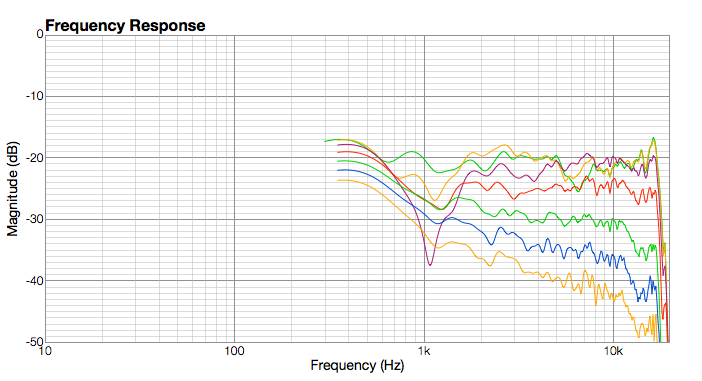
0°-75° down:

By the way, how is your tweeter-ring omni coming along?
Thanks for posting verticals. Very much expected given physics of speaker and crossover point.
With Pluto radiation is very omnidirectional to about 3kHz. Radiation pattern collapses to characteristic of single small dynamic driver in tiny baffle. Hemispherical wavefront projected towards listener is extremely uniform. Pluto follows design principles of omnidirectional as limited by constraints of two drivers. A critical design consideration is driver integration in terms of <1/4 wavelength driver spacing at crossover frequency to avoid lobes in vertical plane. Reflections from floor and ceiling reveal only that a floor and ceiling are present. Speaker with vertical lobes reveals speaker as two sources through crossover region.
Majority of direct radiator designs fail on driver integration. All multiple horn and horn with direct radiators designs fail on driver integration. Size of horn mouth and size of direct radiator for matching horizontal pattern of horn guarantee separation and crossover point leading to lobes. At very least, lobe behavior places additional constraints on speaker and listener location to hide speaker's multiple source behavior.
Thanks for inquiring about tweeter-ring omni. Yes, a work in progress. The circular array has CBT behavior. And comb filtering at high frequency, which is easy to measure, and easy to hear with measurement signals, but virtually invisible with normal program.
As proof of concept it demonstrates that brightening HF reflections from all vertical surfaces keeps contrast with very bright direct sound. Pluto as two way sounds different with changes to toe-in, by very reason that although modeled on omnidirectional principles, it is not omnidirectional above about 3kHz. Above 3kHz, directional cues are virtually all intensity based. With tweeter-ring, speaker placement to wall proximity seems to have much less effect. Spectral balance is better maintained.
Even with 16 tweeters, they just don't behave well down to where Pluto woofer, SEAS L16RN-SL, behaves well.
Exploration continues:
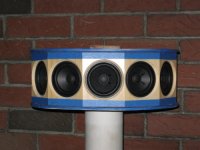
And a sketch view:
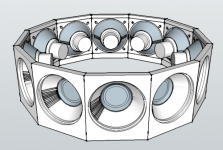
Twelve 3" Aura NS3-194-16A in ring structure. Blue tape is protecting wood from plasticine used as temporary seal while exploring stuffing and small volume. Ring structure has fascinating behavior. Placed on end of 4ft 12" diameter tube, and looking down tube through ring, sharp sound image appears below floor. It reminded me of Tom Danley's description of sound when head is placed into opening of Synergy Horn (A horn speaker subscribing to <1/4 wavelength spacing of drivers through crossover point(s)). With additional 12" tube stacked on ring, a large speaker results. It may be viewed as very omnidirectional in horizontal plane, and CBT characteristics give it very wide vertical behavior too.
Prior to putting temporary end plates on, I set rings and plates on floor and stood on them to seal them. Direct sound through feet was intense. Most of sound appeared from whatever direction I was looking.
As pictured, listening is quite good with just about any placement in room. Image is wide, deep, detailed, and very stable. Stuffing and final internal volume still need optimization. Making it two-way with really big tweeter-ring is a possibility too.
I don't think that has to be strictly true. Maybe for the full <1/4 wavelength spacing, but you can push vertical nulls out really far with a waveguide and direct radiator combo, and eliminate horizontal ones. Of course, Wayne and Earl both have different points at which they don't see any point in compromising anything else to that particular idea further, for somewhat different reasons. I'm just saying you could get the acoustic centers pretty darn close if you made it a primary goal. And then there's the Synergy..All multiple horn and horn with direct radiators designs fail on driver integration. Size of horn mouth and size of direct radiator for matching horizontal pattern of horn guarantee separation and crossover point leading to lobes.
While polar’s in room are “problematic” one can get an idea how well a speaker will interface with a boundary by going outside and measuring two identical loudspeakers.
This would be using another loudspeaker for the “mirror image” one would have with a physical boundary in the same location.
For a loudspeaker to be array able acoustically (compatible with an identical source or physical boundary) it cannot interfere significantly with the adjacent speaker.
When that is the case, one can also place it on a boundary in the same geometry with a similar (absence of audible change) result.
If one isn’t able to make a polar plot, playing music or better yet pink noise through both will make interference very audible as you move from the coverage of one to the other. In fact, pink noise and moving around is a fair audible test for a single speaker as well to indicate self interference.
Ideally (and it is rare but still possible) to have NO audible seam or comb filtering / swishyness as you move back and forth.
Fwiw, I can’t say that I have ever seen / measured a loudspeaker that had cancellation notches alone, that went away when on a boundary or with an adjacent source.
Best,
Tom
This would be using another loudspeaker for the “mirror image” one would have with a physical boundary in the same location.
For a loudspeaker to be array able acoustically (compatible with an identical source or physical boundary) it cannot interfere significantly with the adjacent speaker.
When that is the case, one can also place it on a boundary in the same geometry with a similar (absence of audible change) result.
If one isn’t able to make a polar plot, playing music or better yet pink noise through both will make interference very audible as you move from the coverage of one to the other. In fact, pink noise and moving around is a fair audible test for a single speaker as well to indicate self interference.
Ideally (and it is rare but still possible) to have NO audible seam or comb filtering / swishyness as you move back and forth.
Fwiw, I can’t say that I have ever seen / measured a loudspeaker that had cancellation notches alone, that went away when on a boundary or with an adjacent source.
Best,
Tom
Here's the vertical polar of Nathan.
Source: 3D3A Lab at Princeton University
An externally hosted image should be here but it was not working when we last tested it.
Source: 3D3A Lab at Princeton University
That was supposed to say "to further that particular ideal". I don't know why it came out all yoda-ized. Sometimes I wonder about this brain of mine...both have different points at which they don't see any point in compromising anything else to that particular idea further, for somewhat different reasons.
The gap is an open space, not a constrained tuned space. The open space isn't going to act as port to the entire room........ Resonances and standing waves are not for HF. Either way, it can be closed for the fearful.Leaving the gap can produce a kind of diffuse echo which seems frequency dependent.
Unless the path taken runs the drivers/baffles beyond their design capabilities, then it will be worse. A non-coincident crossover can't be perfect, but can be made so good that it almost doesn't matter.
Those jubilee upper horns don't look quite up to doing 400Hz without being flush with the corner. Do they use a single driver?
The Jubilee uses two 12" drivers in a V folded horn. Many exchange the top driver with TAD TD-4002 and say it both measures and sounds better.
Then you have JBL Hartsfield. What a cool speaker!
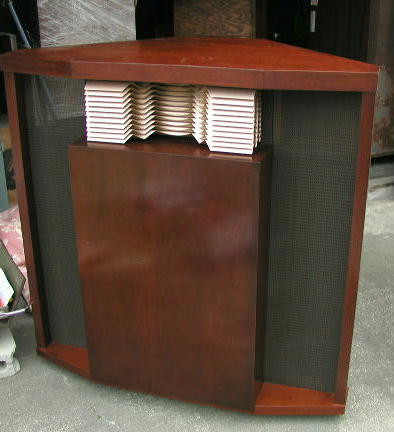
http://www.youtube.com/watch?v=5TkRIeSN2G4
Last edited:
. Of course, Wayne and Earl both have different points at which they don't see any point in compromising anything else to that particular idea further, for somewhat different reasons. I'm just saying you could get the acoustic centers pretty darn close if you made it a primary goal. And then there's the Synergy..
I just do not see a big problem with measurements like those that are shown. The main lobe is sufficiently wide (at least 40 degrees) that it easily covers the seating area vertically (remember that in the vertical sense the range of the listeners is quite narrow). One need never be in one of the nulls. Sure it would be great to not have any lobes at all but physics says that is not possible without coincident drivers. And that means a small horn and that means bigger problems than those that you are trying to solve. It makes no sense to point to one specific flaw and say "see that's a bad design". One has to consider the tradeoffs and what competing approaches have in the way of compromises. In this aspect there are things that can be argued depending on what you are trying to do. But as far as vertical lobes go, since I try and kill the floor and ceiling reflections in the room anyways, these lobes are a non-issue.
If one isn’t able to make a polar plot, playing music or better yet pink noise through both will make interference very audible as you move from the coverage of one to the other. In fact, pink noise and moving around is a fair audible test for a single speaker as well to indicate self interference.
Tom
Hi Tom, except that measurements don't lie while the listener hears what he wants to hear. It depends on how objective you are. If you don't want to hear a problem then you won't. And if you do you will hear one whether it is there or not.
I have seen so many embarrassing moments in listening tests where nothing is change and "that sounds much better" or the system is changed twice back to original and its "much much better". I used to do this just to see how far I could go. I would even do things like go out and say "This is going to sound great!" Pretty much guaranteed what the result would be.
Last edited:
Those aren't guesses - those are measurable, verifiable facts. It's really not something you can agree or disagree with, and to say otherwise is a flat earth argument.
Well I disagree with you, but I am not going to argue with you. I know what you are like.
Here's the vertical polar of Nathan.
Source: 3D3A Lab at Princeton University
You forgot to mention that the Nathan was his speaker of choice because it was better than most of the others (the Genelec was about as good except that it cost five times as much.)
Dr. Cheery's project never got off the ground unfortunately. But I did sell a few pairs to some of his early clients.
Wayne:
Do you have any measurement examples of a corner horn and a two-way waveguide compared in the same room?
I expect the corner horn will measure flatter almost every time, but it would be nice to see some data.
To see an ETC and a waterfall (of LF) would be nice as well.
Do you have any measurement examples of a corner horn and a two-way waveguide compared in the same room?
I expect the corner horn will measure flatter almost every time, but it would be nice to see some data.
To see an ETC and a waterfall (of LF) would be nice as well.
The link below has several measurements of a variety of different speakers taken indoors. They show the tell-tale notches from boundary interference and room modes. Constant directivity cornerhorns do not suffer from self-interference notches, which are usually in the 100Hz to 200Hz range, depending on the distance to nearest boundaries. They do still suffer from room modes, of course, which can be mitigate using multisubs, just like any other loudspeaker.
Here are a couple articles about the self-interference notches most speakers suffer from:
There is a lot more information out there on this problem, it is well-understood in the industry. Many recording studios employ soffit mounting, keeping their baffles flush with the front wall to remove reflection notches from that boundary. A constant directivity corenerhorn takes this one step further, by being acoustically close to both the front wall and the ipsilateral wall.
Here are a couple articles about the self-interference notches most speakers suffer from:
There is a lot more information out there on this problem, it is well-understood in the industry. Many recording studios employ soffit mounting, keeping their baffles flush with the front wall to remove reflection notches from that boundary. A constant directivity corenerhorn takes this one step further, by being acoustically close to both the front wall and the ipsilateral wall.
Well sure. If you set out to fool people, you probably will. Nothing new there. I've been in tests like that, even fooled myself.I have seen so many embarrassing moments in listening tests where nothing is change and "that sounds much better" or the system is changed twice back to original and its "much much better".
But I've been in just as many tests were the listeners report no change, even if there was one. Or report "I don't know". It goes both ways.
I was intrigued by Wayne's comments on the corner horn the last time the subject came up and ran some room simulations.
Note: These are only dirac impulse simulations in a bare room. But it's interesting to see how the reflections might play out. A speaker out in the room and a speaker in the corner. The green reflections are about 10-12dB down from the direct wave.
Comments?
Note: These are only dirac impulse simulations in a bare room. But it's interesting to see how the reflections might play out. A speaker out in the room and a speaker in the corner. The green reflections are about 10-12dB down from the direct wave.
Comments?
Attachments
- Status
- This old topic is closed. If you want to reopen this topic, contact a moderator using the "Report Post" button.
- Home
- Loudspeakers
- Multi-Way
- Uniform Directivity - How important is it?
